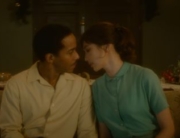![]() This steadily absorbing man-adrift-on-a-damaged-sailboat saga has possibly the three most suspenseful sequences of the year and in many ways blows another survival-against-the odds-odyssey, Gravity, out of the water (more puns to come).
This steadily absorbing man-adrift-on-a-damaged-sailboat saga has possibly the three most suspenseful sequences of the year and in many ways blows another survival-against-the odds-odyssey, Gravity, out of the water (more puns to come).
J. C. Chandor introduced his clean, nonfussy, direct storytelling in the verbose all-star economic meltdown primer Margin Call. Here, his storyline has been slimmed down to the essentials as one nameless man (referred to in the credits as “Our Man”) takes on the elements after his recreational 39-foot long 1978 Cal 39 sailboat collides with a shipping container that could have fallen from a cargo ship or may have been debris caused by the 2011 tsunami.
The audience is just as much at sea as the nameless protagonist, who serves as an everyman, since we know next to nothing about him. We can project almost any backstory onto him that would have brought him out as a solo traveler on the Indian Ocean. (The film was shot in Baja California, presumably in the same tank as Titanic, the Bahamas, and California, with post-production in Toronto.)
We can ascertain that Our Man has sailing experience and has been prepared for the worst of contingencies. Also, he wears a wedding ring. Far from a character study under duress, the nearly wordless, one-man-show narrative is made up of incidents and reactions. That he’s played by Robert Redford means the film is anchored by a steady, almost calm determination. Redford’s never been an actor of grand emotive gestures, but that’s not to diminish how effectively Chandor employs him in a performance that’s 99 percent reactive. In only one moment does the stranded man unleash his anger and frustration with a very appropriate F-bomb. For the most part, Chandor leaves it to the audience to respond. A more emotional actor would have stolen our thunder. And do we really want an over-the-top mental breakdown? Then where’s the hope?
We figure out as armchair travelers what this lone sailor is doing and why. Most of his actions will be self-explanatory: taking apart the defective electronic equipment to strip away the salt or desalting water with the bare essentials. But he isn’t an amorphous stand-in for mankind. He takes the time to shave before an impending storm hits. For vanity’s sake, a sense of normalcy, or to counteract fear? If life should, in fact, go on, why would someone with Robert Redford’s looks want to resemble the Unabomber? There are a few other telling details that don’t distract from the film’s tight focus.
The sparse and well-modulated direction carries over to the strategic use of music. Chandor leaves well enough alone, and the moans and creaks of the dilapidated and sinking boat convey more of a threat than a bass-heavy musical motif. Only a few times does the issue of credibility rear its head. (Ah, shouldn’t there have been some water in the boat after it was dunked underwater by a tempest?) Nevertheless, the list of goofs on Imdb.com won’t be as lengthy as Gravity’s. Nor is the success of this film tied to its special effect budget. Another plus: there’s no annoying, time-killing dialogue about a romantic mishap at Mardi Gras, 1987. If you want that, go see George Clooney.

















Leave A Comment